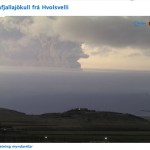Grading grading grading!
A webcam capture of the eruptive plume from Eyjafjallajökull on the morning of May 6, 2010.
News:
A quick update on the Eyjafjallajökull eruption: The volcano has been producing an impressive ash plume over the last day (see image above). The current ash plume is reaching 5.8-6 km height (19-20,000 ft) - and causing some trouble over Ireland and Scotland. However, much of airspace closed yesterday has reopened (for now). You can see two new images of the ash plume over at the NASA Earth Observatory. As for the continued fallout from the ash plume from April,…
volcanoes and aviation
A shot of the strombolian activity at the vent of Eyjafjallajökull, taken on May 4, 2010. Image courtesy of the Iceland Met Office.
The latest news from the Eyjafjallajökull eruption has the volcano erupting more explosively again (see above), possibly due to an increased influx of water into the vent area - in any case, the ash has become denser (by volume in the air) and the plume is higher (see below) than in the last couple of weeks. The rate of lava flow extrusion has also gone down in the last few days. The latest update from the Iceland Met Office has a lot of details on the current…
Bezymianny in Kamchatka, one of the many volcanoes in eastern Russia that will no longer be monitored by KVERT.
In some bad news for volcano watchers (and the general public, too), Russia has decided to stop funding KVERT (the Russian equivalent of the Alaska Volcano Observatory), the institute that monitors and researches volcanic eruptions on the Kamchatka Peninsula and the Kuril Islands in the western Pacific. Here is the news release from KVERT:
Due to a loss of government funding beginning February 01, 2010, KVERT will no longer
distribute information regarding volcanic activity in…
